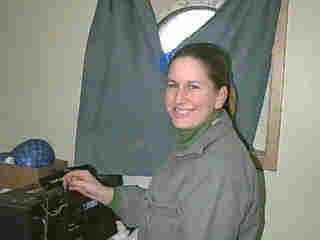
|
|
7 February, 1998
Gould-en Greetings!
Today, the clouds parted and we have had a sunny day! There is no place
more beautiful than this when the fog lifts and the sun brightens the seas
and icebergs all around. The humidity is so low that there is very little
atmospheric interference and distances are hard to judge. What may look
like it is a mile or two away is actually 20 miles!
My roommate happens to be one of the few graduate students on board
(University of California Santa Barbara), but she is here as a volunteer
and not working on her own research. She is working for Dr. Ray Smith, who
did much of the founding research for bio-optics. DeDe has two activities
that she does here on the ship that we discussed. The first one is to help
deploy the PRR (Profiling Reflectance Radiometer). The PRR is the link
between satellite imagery and physical testing of the water. The PRR
"sees" what the satellite "sees" of the water's down-welling irradiance and
up-welling radiance. (That means that things such as water layers and
phytoplankton blooms can be detected because of the way they reflect and
refract the light.) Then the water is directly sampled for chlorophyll and
salinity as well as compared to the CTD data so that a true interpretation
of the data from the satellite imagery can be made. As DeDe explains, "The
ultimate goal is to be able to tell what's going on in the ocean without
direct sampling. This way a more global picture can be formed instead of
sampling just a little piece." She has reason to want to sample indirectly
because the other thing she has to do is test the chlorophyll levels in the
water column!
How would knowing the salinity help in determining the water layers?
Answer tomorrow.
Warm regards,
Mrs. D

Contact the TEA in the field at
.
If you cannot connect through your browser, copy the
TEA's e-mail address in the "To:" line of
your favorite e-mail package.
|
